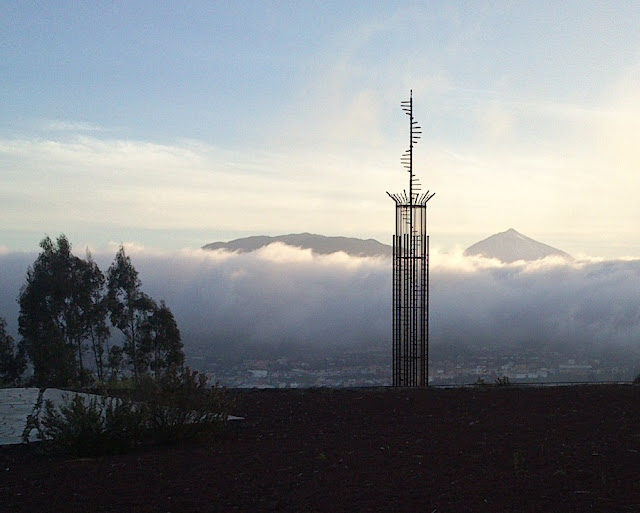 |
| International Tenerife Memorial March 27, 1977 Image: Jesús Manuel Pérez Triana [CC0], via Wikimedia Commons |
On the 30th Anniversary of the Tenerife Disaster on March 27th, 1977, Tenerife paid homage to the victims of the accident at Los Rodeos. Families of the those who died, as well as survivors of the tragedy and members of the island's authorities, celebrated a memorial service at the Auditorio de Tenerife. Karen Tafuri, who lost her mother, Jeanne Wilder, in the crash, spoke of her experience, in representation of victims from the United States. While, Jan Groenewoud, President of the Foundation for families of the victims, remembered the seven people - among them, both of his parents and two sisters - he lost on that date.
The 583 victims now have their Stairway to Heaven
An emotional homage was paid to the 583 victims of the crash yesterday afternoon, when the International Tenerife Memorial was inaugurated on the Mesa Mota mountain in La Laguna, Tenerife, overlooking the airport and site of the disaster. It was also revealed yesterday, that the Dutch artist, Rudi van de Wint, who designed the over 18 metres tall monument, sadly died shortly after completing it.The Foundation Relatives Victims Tenerife donated the International Tenerife Memorial to the island's authorities. The Cabildo accepted the monument with gratitude: an artwork 18 metres tall designed by the Dutch artist Rudi van de Wint. The Corten steel monument arrived on the Canary island of Tenerife at the end of January, aboard ship from Flushing (Vlissingen).
The artwork, entitled 'De Wenteltrap' (literally translated, spiral staircase) - symbol of infinity - will serve as a monument to commemorate all the victims of the largest disaster in the history of civil aviation, which occurred on March 27, 1977 at Los Rodeos airport, Tenerife-Norte (TFN). KLM Boeing 747 flight number KL4805 crashed on the runway into a Boeing 747 of Pan American Airlines (Pan Am 1736). All 248 people aboard the KLM aircraft died; 335 of the 396 aboard the Pan Am aircraft perished, with 61 survivors.
INAUGURATION INTERNATIONAL TENERIFE MEMORIAL - MARCH 27 1977 - 2007 - English version from Int Tenerife-Memorial.org on Vimeo.
The monument was unveiled in the presence of Spanish, American and Dutch surviving relatives and government representatives. Prior to the formal dedication, for the first time since the disaster occurred 30 years ago there was an international memorial service in the Auditorio de Tenerife, in the capital, Santa Cruz. Dutch and Spanish heads of state have been invited to both ceremonies.
Air Traffic Controller speaks to the media for the first time
Fernando Azcúnaga, who was one of the three controllers on duty in the tower at Los Rodeos on that fateful day in 1977, has spoken to the media for the first time in these 30 years. Previously, he had refused to speak publicly, but finally conceded on the request of his wife. Azcúnaga talked of his frustration at not having been able to do anything.Now 71 and retired in 2000, Azcúnaga is married and father of four children (one of whom died in a traffic accident). He now lives in Tegueste, in the north of Tenerife and runs a parquet flooring company. Although he considers himself a strong person, Azcúnaga tells how the disaster changed his character and how he felt very saddened. "It was not my fault, but I was implicated.", he says. The accident still moves him enormously and it is something he carries in his heart.
The insurance companies, he adds, harassed him in the aftermath of the crash. "There were a load of insurance companies and the easiest for them would be to put the blame on the controller so that everything would be paid by the Spanish Government", he says. (In 1977, ATC was still handled by the military in Spain.)
He has also spoken out about the rumour, reported on various occasions and included in certain documentaries, that the controllers were listening to a football match on the radio. This, Azcúnaga considers absurd. For one thing, Air Traffic Controllers work with headphones on, secondly, there is the evidence that in none of the tapes is there any sound of a goal or anything of the like.
Runway Safety Debated on Anniversary of Deadly Crash
Meanwhile yesterday, Robert Bragg, former Pan American World Airlines co-pilot, spoke to the National Transportation Safety Board at a safety forum in Washington, D.C., to recall the moment when his 747 was taxiing at Los Rodeos Airport and a KLM jumbo jet came barrelling down the runway for its take off.Anecdote
Much has already been written about the entire chain of events that added up to allow this accident to happen, any one of which, if it hadn't occurred might have helped to prevent it from doing so ... If only it hadn't been foggy, if only there had been lights on the runway, ground radar (which Los Rodeos does now have), if only there hadn't been a terrorist bomb in Gran Canaria ...Nevertheless, there is one further piece of anecdotal information that I found at the foot of this article about the crash. I've never been able to confirm this information, but it is certainly ironic, if not a bit creepy, if it is indeed fact and, while it sounds like the kind of story that the English might tell about "Spanish builders", the thing is, I have only ever read this report in Spanish, it translates:
During the Second World War, Hitler insisted to Franco's regime on the construction of an aerodrome in Tenerife to give cover for his troops in North Africa. German technicians were sent to initiate studies for the design of the airport, which were later presented to the Spanish authorities. These latter decided to postpone the construction, but they held onto the plans made by the Germans, who in those days were considered as the experts in airport design and construction.
Some years later, after the end of the war, the Spanish authorities decided that it was time to construct the airport in Tenerife, for which they decided to resort to the valuable documents provided by the Germans. Amongst these was a map of the area, on which was clearly marked a great big red cross. The Spanish "supposed" that this marked the ideal location for the airport and, commenced its construction based on the German maps. What they did not know, is that the big red cross indicated the area where an airport should never be built.





 After more than 20 years, posts here will now only be occasional (
After more than 20 years, posts here will now only be occasional (







